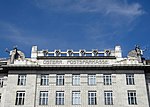The Bürgertheater was a theatre in Vienna.
The Wiener Bürgertheater was erected in 1905 in the Third District (3 Bezirk), at Vordere Zollamtsstraße 13. It was designed by the architects Franz von Krauss and Josef Tölk. The official opening took place on December 7, 1905, with the performance of Der alte Herr (The Old Man), by Beatrice Dvorsky with the mayor of Vienna, Karl Lueger, attending.
The first director was actor and author Oskar Fronz, who managed the theatre until his death in 1925. The venue was unsuccessful in its early years until Fronz adapted the Bürgertheater for operetta performances in 1910 and Edmund Eysler became the house composer. From 1926, Revue-operettas were common, particularly those featuring Karl Farkas and his partner, Fritz Grünbaum. The theatre closed in the early years of World War II, but reopened under the direction of Robert Valberg in 1942.
In September 1945, Franz Stoss was named director, and the Bürgertheater became a satellite theatre of the Theater in der Josefstadt. In 1953, Stoss was followed by Harald Röbbeling who renamed the Bürgertheater Broadwaybühne (Broadway-stage) in an attempt to give it a new direction. This was unsuccessful causing huge financial losses that forced the theatre to close. The building was subsequently used for, among other purposes, the transmission hub for the American occupying force and a sales exhibition which was previously housed at the Vienna Stock Exchange.
During the 1959-61 great death of the theatres in Vienna - in which the Wiener Stadttheater (in Laudongasse) and the "Scala", the former Johann Strauss Theater, were also affected - the Bürgertheater was demolished in 1960. The headquarters of the Viennese Zentralsparkasse was erected on the site, with a bridge over the adjoining slip road, designed by Arthur Perotti and Anton Potyka.











